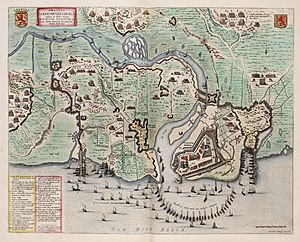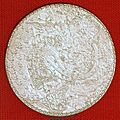Siege of Geertruidenberg (1593) facts for kids
Quick facts for kids Siege of Geertruidenberg |
|||||||
|---|---|---|---|---|---|---|---|
| Part of the Eighty Years' War & the Anglo–Spanish War | |||||||
 Siege of Geertruidenberg in 1594 by Giovanni Battista Boazio - the semi circle curve at bottom are brigantines blockading the city |
|||||||
|
|||||||
| Belligerents | |||||||
| Commanders and leaders | |||||||
| Strength | |||||||
| 12,000 | 800 (Garrison) 8,000 troops & 1,500 cavalry (Relief) |
||||||
| Casualties and losses | |||||||
| Light 500 to disease |
1,000 killed wounded or captured | ||||||
The Siege of Geertruidenberg was a major battle that happened between March 27 and June 24, 1593. It was part of two bigger wars: the Eighty Years' War and the Anglo–Spanish War. During this siege, Dutch and English soldiers, led by Maurice of Nassau and Francis Vere, surrounded the city of Geertruidenberg, which was held by Spanish troops.
What made this siege special was how the attackers used ships. They formed a large semicircle with about one hundred ships on the Mass River. This created a strong blockade to stop anyone from getting in or out by water. A Spanish army, led by the Count of Mansfeld, tried to help the city in May. However, they were defeated and had to leave. After three of the city's governors were killed and no help arrived, the Spanish gave up on June 24, 1593. This victory made Maurice of Nassau very famous as a military leader.
Contents
Why the Siege Happened
In 1573, Geertruidenberg was captured by a mix of English, French, and Dutch forces. But in 1589, the Spanish took it back. They did this by paying off the English soldiers who were supposed to be guarding the town. These English soldiers had not been paid for a long time.
However, the Spanish army was having trouble controlling the local people. When many Spanish soldiers were sent to France to help in another war, the Dutch and English armies saw their chance. They went on the attack under the command of Maurice of Nassau. Maurice used smart tactics, building strong defenses and controlling areas. This helped the Anglo-Dutch forces take many towns in the 1590s.
In 1592, some Dutch leaders wanted to attack Geertruidenberg. But others decided that Groningen was more important. So, Maurice's army focused on Groningen first. They captured Steenwijk in July and Coevorden in September. This made it harder for the Spanish to hold Groningen.
After these wins, the leaders changed their minds. In 1593, they decided to attack Geertruidenberg. This made the people from Zeeland very happy. To help Maurice, a trick was played on the Spanish. A Dutch commander named Philip of Nassau launched a fake attack on Luxembourg. This made the Spanish commander, Count Von Mansfeld, chase Philip to the south. This gave Maurice enough time to surprise the Spanish soldiers in Geertruidenberg.
The Siege Begins
On March 27, 1593, Maurice arrived at Geertruidenberg with his army. He had extra help from English soldiers led by Francis Vere and Scottish soldiers. The first thing they did was block all roads leading into the town. This stopped the Spanish from sending help.
They built several forts on land to completely surround Geertruidenberg. They also built Windmills and dikes to protect themselves. Maurice and his regiments were on the west side. Francis Vere led the attack from the south. Other regiments were set up to the east.
In mid-April, the soldiers started digging trenches and building defenses. They worked very hard because they were paid well and wanted the siege to end quickly. Their defenses were so strong that they were even better than some fortified cities. The trenches had special areas called ravelins with guns. There were also wide water ditches. Instead of a counterscarp, they put rows of sharp wooden piles in the ground.
There were four main forts, connected by smaller ones. More than a hundred cannons were placed on these defenses. The Donge River provided water for the moat. Two bridges connected the different parts of the defenses. The attackers also made sure their camp was safe from any Spanish army trying to help the city.
A unique part of the siege was the naval blockade. One hundred ships formed a semicircle on the old Maas River. Lighter ships called brigantines were on the sides. All the ships were connected by strong ropes or chains. This stopped anyone from entering or leaving the city by water.
On April 8, a key fort on the river was captured by Dutch troops after five days of fighting. This fort was important because it was the only way into the city from that direction. It also gave the attackers an early warning if a Spanish relief force was coming.
During the siege, the camp became a busy place. Local people came from far away to sell food and goods. Even important people, like Louise de Coligny, the wife of William of Orange, visited. They were amazed by how grand and strong the defenses were.
Spanish Attempt to Help
By early May, the Anglo-Dutch forces were very well dug in. Meanwhile, Count Mansfeld, the Spanish commander, heard about Geertruidenberg's situation. He quickly marched his army from Brussels to try and help the city. He even asked his son, Karl von Mansfeld, to bring his soldiers from France, but they couldn't make it.
On May 28, Count Mansfeld arrived with an army of 7,000 foot soldiers and 2,000 horsemen. They set up camp about six miles east of Geertruidenberg. His army could have been bigger, but many soldiers left when they passed through Hainault.
Mansfeld tried to attack the besieging forces, but he soon realized their defenses were too strong. English and Zeeland soldiers, led by Vere, pushed back Mansfeld's leading infantry after heavy fighting. Soon after, a Spanish cavalry charge was defeated, and a supply convoy was ambushed. With more and more losses, Mansfeld pulled his forces back. He stayed a safe distance away from the Anglo-Dutch army.
In early June, heavy rains turned the land around the city into a muddy mess. This made it hard for everyone involved in the siege. By this time, tunnels had been dug under the city walls in three places. The ships blocking the river also fired their cannons every day, along with the land cannons. This caused a lot of damage to the city walls and the city itself.
On June 25, the Sieur de Gissant, one of the city's governors, was killed by a cannon shot. He was the third governor to die during the siege. This was a huge blow to the morale of the soldiers inside the city. When news arrived that Mansfeld could not break through, their spirits dropped even more. The city then sent people to talk with Maurice. They agreed to an honorable surrender. After a three-month siege, Geertruidenberg surrendered to Maurice.
The next day, Mansfeld's army left after hearing the news. The Spanish soldiers from Geertruidenberg were allowed to march out with their weapons and flags. They agreed not to fight for the rest of the war.
What Happened Next
Maurice led his army into the captured city. He immediately started repairing and strengthening its defenses. Scottish soldiers who had helped in the siege stayed to guard the city until the autumn.
The capture of Geertruidenberg was a big win for the Dutch and English armies. It meant they now controlled all the rivers in Holland and Zeeland. Count William of Nassau, another Dutch leader, kept fighting the Spanish army near Groningen. English troops under Francis Vere were sent to help Count William. This forced the Spanish to move their soldiers around. In October, both the Dutch and English armies returned to the Hague for the winter.
The next year, the Spanish tried and failed to take Coevorden back. Finally, Groningen was captured by the Anglo-Dutch forces. This cleared the Spanish out of the Drenthe region.
The victory at Geertruidenberg proved that Maurice of Nassau was a very skilled military commander, especially in sieges. Count William of Nassau praised the victory. He even compared the siege to the famous Battle of Alesia from ancient times.
Images for kids
-
Maurice of Nassau by Emanuel van Meteren
-
Siege of Geertruidenberg; by Jan Luyken
-
Count of Mansfeld by Antonis Mor
See also
 In Spanish: Sitio de Geertruidenberg (1593) para niños
In Spanish: Sitio de Geertruidenberg (1593) para niños





